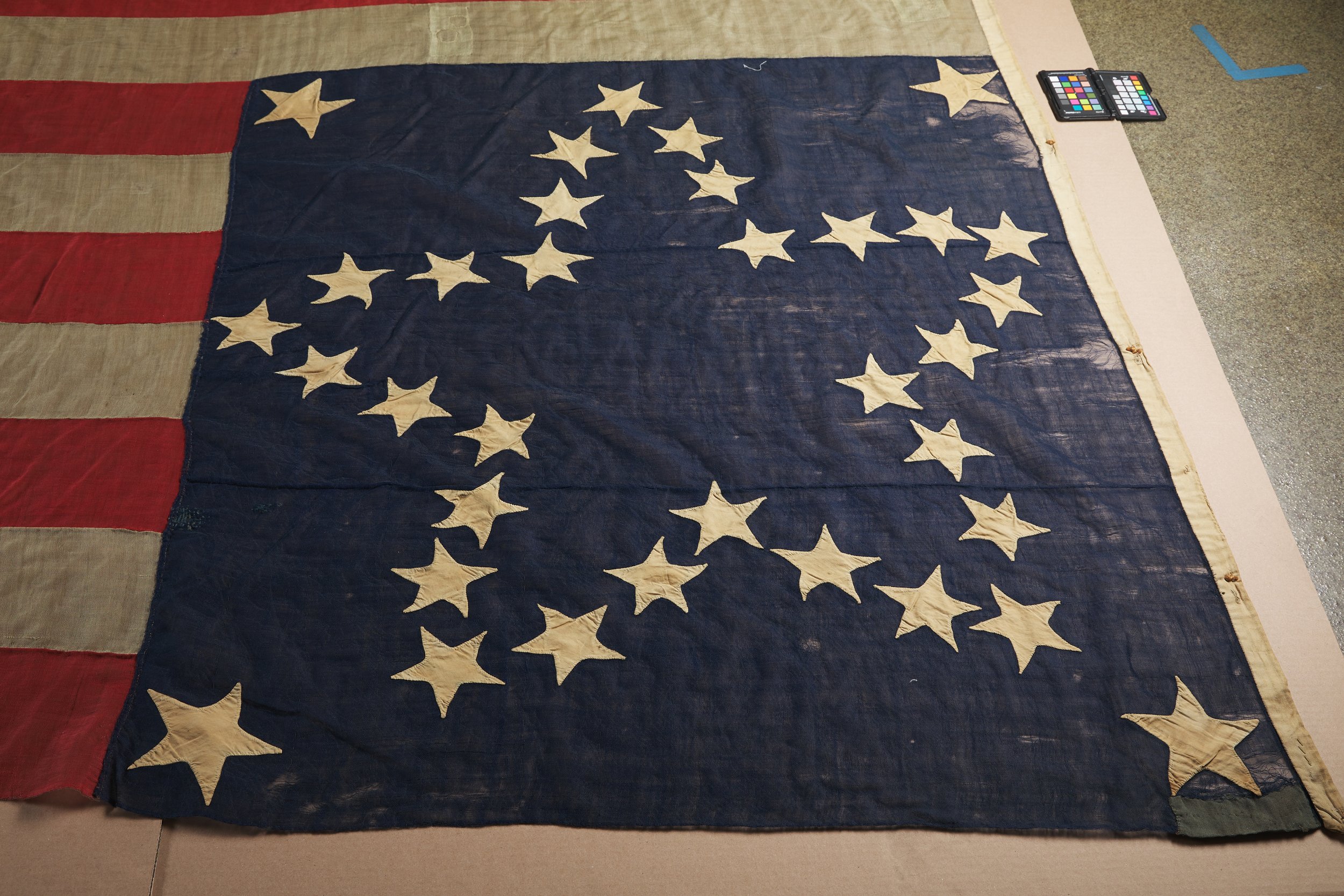Woven within the fabric of the Cass Flag lies a story of patriotism, resilience, and community spirit, dating back to July 3, 1861. Crafted under the dim glow of lanterns by the hands of a determined sewing bee in Cass - now known as Darien, Illinois - this historic artifact embodies the essence of American identity during the tumultuous Civil War era. These days, the Cass Flag is at home in the Old Lace Schoolhouse and Museum under the guardianship of the Darien Historical Society, where the Cass Flag tells the story of the enduring legacy of those who shaped its history.
The Cass Flag, before treatment
Amidst the backdrop of the United States Civil War, the residents of Cass sought to commemorate their patriotism on the eve of Independence Day. Efforts to procure an American flag from Chicago faltered when nineteen-year-old Elijah Bartlett volunteered to ride horseback 20 miles into Chicago to purchase a flag but returned empty-handed. So on July 3, George Heartt took a turn riding into Chicago, returning with the fabric to make a flag instead.
The Cass Flag, before treatment detail
The indomitable spirit of the community emerged. Guided by the skilled hands of Eliza Smart, the young women of Cass held a sewing bee, and the Cass Flag was born. Stitched meticulously throughout the night of July 3, 1861, this imposing 11-foot by 7-foot textile features the "Great Star" pattern of 34 stars representing each of the US States at that time. The concept of arranging stars in this unique pattern emerged after the War of 1812, proposed by Captain Samuel Reid. Reid, a distinguished naval hero, suggested grouping the stars into one large star shape for consistency and easy recognition as more states joined the Union. However, President James Monroe rejected Reid's proposal for the star pattern due to cost concerns; Monroe's concerns led to the eventual adoption of the simpler row design. However, Monroe did not specify an official design, allowing anyone to still create the Great Star pattern if they chose. Today, its scarcity and aesthetic charm have heightened the demand for American flags featuring this arrangement.
The Cass Flag, before treatment detail of previous repair at center of image
Ready by morning, the flag debuted at the Fourth of July parade on July 4, 1861. Over the decades, the Cass Flag was entrusted to community members who saw to its care and ensured it was flown on patriotic occasions. But at some point, the flag made an unexpected sojourn, ending up in the Downers Grove library, in a display case with Civil War memorabilia. Its significance lay dormant until 1986, when the Downers Grove Historical Society unearthed it from obscurity, rediscovering the history of this flag in the library's collection. Finally, in 2018, the flag was gifted to the Downers Grove Historical Society. Understanding the community and historical significance of the Cass Flag, the Darien Historical Society embarked on a comprehensive preservation endeavor in collaboration with The Conservation Center. With meticulous attention to detail, every step of the process was undertaken to ensure the flag's preservation for posterity.
The Cass Flag, before treatment detail under raking light
Given the 163-year-old age of the flag, it was in remarkable condition when it arrived at The Center, clearly having been well-cared for all of its life. The preservation journey began with thorough documentation through high-resolution photography, capturing every intricate detail before preparing the flag for display. The photography serves not only as a visual record of its current state but also as a means of digitally preserving the flag for future study.
The Cass Flag, before treatment detail with a small patch at the left edge
Next, the Cass Flag was mounted with utmost care and precision, employing conservation-grade materials. At 11-foot by 7-foot, it would not be possible to display the flag in its entirety because, at that size, the Darien Historical Society would not be able to fit it in their building. Instead, the flag was thoughtfully folded in collaboration with the Darien Historical Society before being mounted to an archival linen-wrapped strainer. Linen-wrapped spacers ensured a safe distance between the delicate textile and the glazing, safeguarding it from potential damage. Optium Museum Acrylic, renowned for its anti-reflective and UV-protective properties, was utilized to shield the flag from environmental degradation.
The Cass Flag, after framing
The Cass Flag, after framing verso
Now with the Cass Flag safely framed, the team moved on to phase two - framing a high-resolution archival print of the flag. This allows for the display of the folded original and a scale image of the entire flag. A high-quality archival print of the flag was produced using archival ink on acid-free paper. This reproduction, mounted on archival materials and framed to conservation standards, serves as a tangible representation of the flag in its entirety.
The Cass Flag - digital reproduction, after framing
The Cass Flag - digital reproduction, after framing verso
In preserving the Cass Flag, the Darien Historical Society pays homage to the individuals who crafted it and to the enduring spirit of the community it represents. As it hangs proudly in the Old Lace Schoolhouse and Museum, the Cass Flag will continue to serve as a tangible link to America's past, inspiring and educating future generations about the resilience and unity of its people during times of adversity.
The Cass Flag, after framing
The Cass Flag - digital reproduction, after framing











